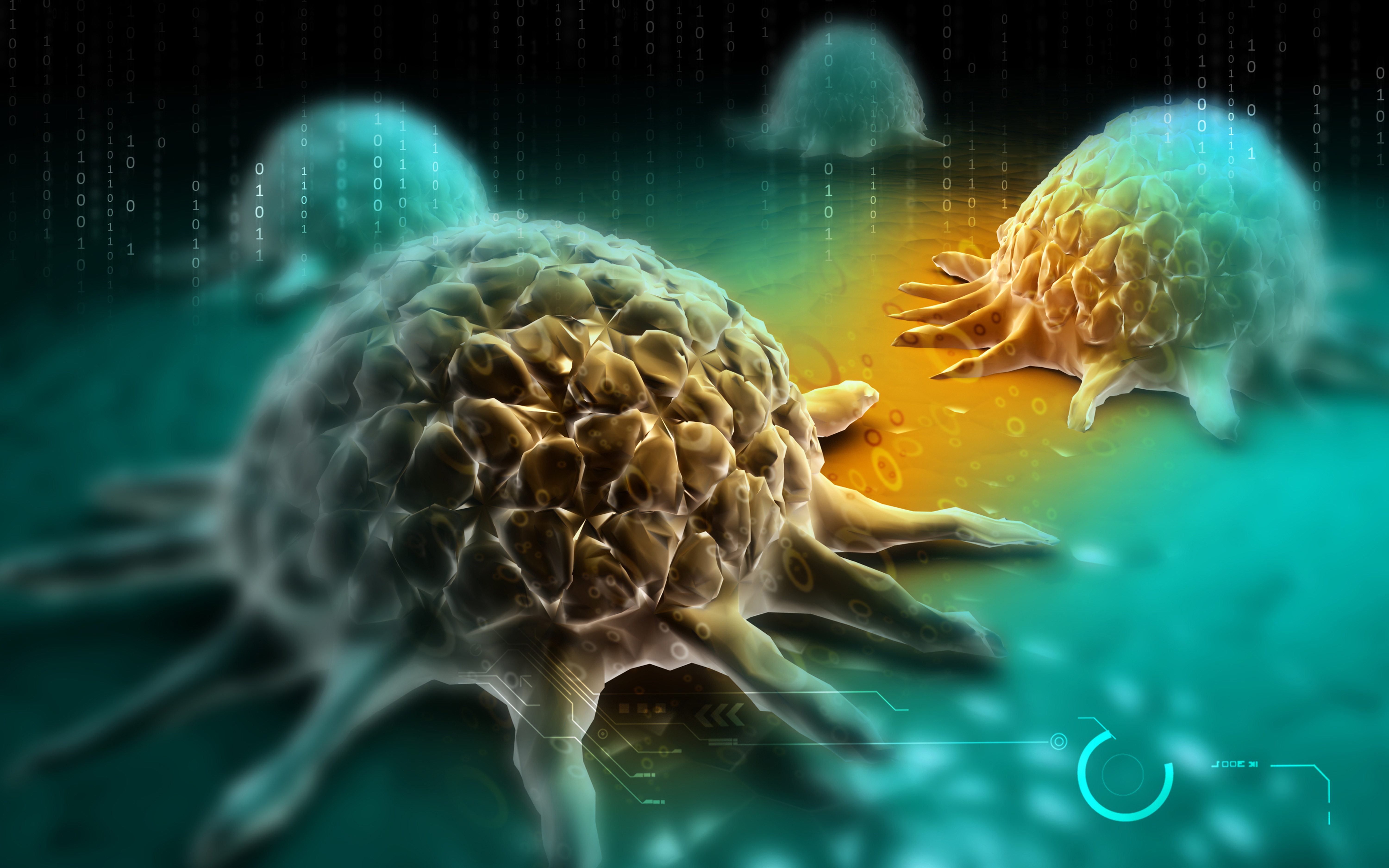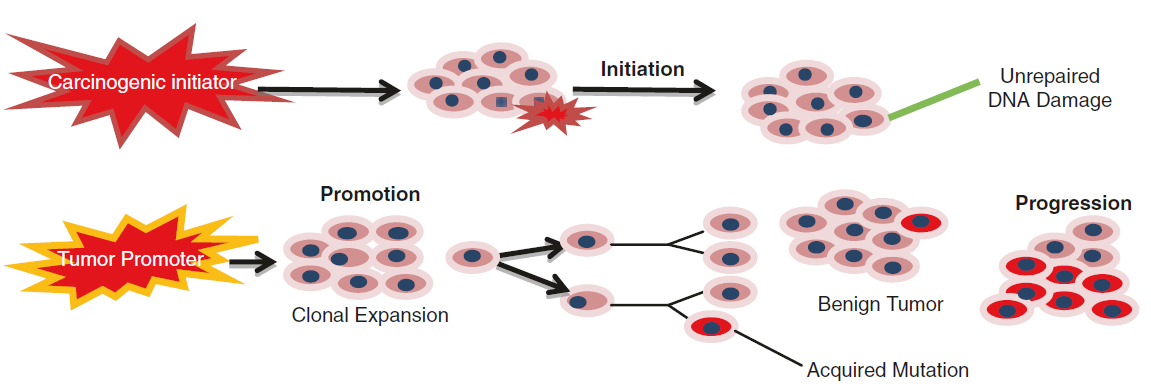Cancer
What Is Cancer?

Cancer is fundamentally a disease of failure of regulation of tissue growth with the potential to invade or spread to other parts of the body, which involves abnormal cell growth and gene variation. Possible signs and symptoms of cancer include a lump, abnormal bleeding, unexplained weight loss, prolonged cough, and a change in bowel movement. Many cancers can be prevented by keeping healthy lifestyle, which includes not smoking, not drinking too much alcohol, eating more vegetables, fruits and whole grains, not eating too much processed and red meat, maintaining a healthy weight, avoiding too much sunlight exposure, and vaccination against certain infectious diseases.
Classification of Cancer
Tumors can be either benign or malignant. Benign tumors are not cancerous, tumors cells do not extend to other parts of the body. Malignant tumors are cancerous, tumor cells invade nearby tissues and extend to other parts of the body, which is termed as metastasis. There are hundreds of different cancers from histological point of view which are grouped into six major categories:
| Category | Description | Examples |
| Carcinoma | Carcinoma is any malignant cancer that originates from epithelial tissues lining the inner or outer surfaces of the body, generally arising from endodermal or ectodermal germ layers during embryogenesis. | Breast cancer, colon cancer, lung cancer, etc. |
| Sarcoma | Sarcoma is a malignancy that originates from altered cells of mesenchymal origin in bone, muscle, or connective tissue. They occur rarely in humans. | Askin’s tumor, sarcoma botryoides, chondrosarcoma, etc. |
| Leukemia | Leukemia is a neoplastic disease that usually begins in the bone marrow and results in the abnormal development of white blood cells and is generally classified into acute and chronic forms. | ALL, AML, CLL, CML, etc. |
| Lymphoma | Lymphoma is a kind of blood cell tumor of lymphocytes. It originates in the glands or nodes of the lymphatic system, a network of vessels, nodes, and organs that purify bodily fluids and develop infection fighting white blood cells or lymphocytes. | Hodgkin lymphomas, non-Hodgkin lymphomas |
| Myeloma | Myeloma arises in the plasma cells of bone marrow. Sometimes myeloma cells accumulate in one bone and form a single tumor called plasmacytoma. Yet in other cases, the myeloma cells accumulate in several bones developing many tumors termed as multiple myeloma. | Plasmacytoma, multiple myeloma |
| Adenocarcinoma | Adenocarcinoma is a cancer of epithelial tissue that has glandular origin, glandular characteristics, or both. They form the part of larger grouping of carcinomas. Carcinoma is just not limited to epithelial or skin or glands but a diversity of other tissues that lines the cavities and organs of the body. | Invasive ductal carcinoma, ductal carcinoma, invasive lobular carcinoma, etc. |
| Blastoma | Blastoma arises in embryonic tissue of organs. It is a cancerous tumor that originates from the immature cells that form the basis for an organ’s structure. It occurs in the cells which are undifferentiated, i.e., they have not developed a specific role within the body yet. It usually occurs in childhood and may rarely occur in early adulthood. | Nephroblastoma, medulloblastoma, retinoblastoma, etc. |
Factors Affecting Cancer Development
There are a number of intrinsic and extrinsic features coupled with the progression of cancer. The intrinsic features consist of age and hormonal significance of the individual, ancestral history, and hereditary make. The external features comprise diet and lifestyle, smoking and alcohol use, contact to deadly chemicals and radiation, several infections, etc.
| Intrinsic Factors | |
| Age and Hormonal Status | Cancer has been suggested to occur at late stages of life. A number of cancers are age dependent like they occur in people above 50–55 years. Nevertheless, no age group is immune to this disease. Hormonal factors play an essential role in the development of gender-specific cancers, e.g., estrogens in cancers of the ovary and uterus in female. |
| Family Record | A number of cancers are designated to have a relationship with ancestral incidences; e.g., a woman having close family members like grandmother, mother, maternal aunt, or sister who have undergone breast cancer is 3 times at advanced threat of developing breast cancer compared to not having such a familial account. |
| Genetic Predisposition | Certain genetic conditions predispose individuals to cancer like in the case of those with genetic conditions like xeroderma pigmentosum, ataxia telangiectasia, Bloom’s syndrome, and Fanconi’s anemia that are found to be extremely vulnerable to diverse kinds of malignancy. |
| Extrinsic Factors | |
| Diet, alcohol, and tobacco use | Personal habits like taking alcohol, tobacco chewing, smoking, and diet contribute more than 50 % of all cancers. Breast cancer has been associated with high-fat diet and obesity. Likewise deep-fried, overcooked food and high-salt food are coupled by way of escalating gastric cancer incidences. It has been reported that there is an increase in the cancers of upper alimentary canal and buccal mucosa due to nonsmoking tobacco habits like chewing. There is also an increase in the risk of liver and bladder cancers due to alcoholism. |
| Radiation | Ionizing radiation has both initiating and promoting properties which has been obtained from reports on the occupationally exposed workers like early radiologists, radium dial painters, and atom bomb sufferers. It has been found that the radiation-induced tumors have comparatively long latencies varying as per species. |
| Viruses | Cancer-inducing viruses play a vital function in explicit human cancers like human papillomavirus in cervical cancer, human T-cell leukemia in leukemia, hepatitis B virus in hepatocellular carcinoma, and Epstein–Barr virus in Burkitt lymphoma and nasopharyngeal carcinoma. |
| Free Radicals | During normal metabolic processes and by interacting with extrinsic contaminated agents like radiation and lethal chemicals, reactive oxygen species (ROS) and other free radicals in the body are produced. ROS includes superoxide anions, hydroxyl radicals, peroxy-radicals, and hydroperoxides. They lead to cell transformation via interacting with DNA and develop genetic aberrations and chromosomal abnormalities. They play a key task in the initiation of malignancy by producing DNA adducts and DNA mutations. |
Stages of Cancer

In vitro, in vivo, and epidemiologic studies have enabled researchers to affirm that neoplastic pathogenesis is a complex process from functional aspects which can be divided into three distinct stages involving changes in the genome’s structure.
| Stages | Description |
| Initiation | It forms the first stage of carcinogenesis characterized by irreversible genetic changes which predispose vulnerable normal cells to malign evolution, and immortality has been concluded from various studies. It is a speedy, permanent phenomenon which is transmitted to daughter cells. After successive genotypical and phenotypical changes are initiated, the cell is converted into a neoplastic one. The initiated cell is similar to the remaining cells from a phenotypical perspective and undergoes mutations which induce proliferation but not differentiation. It has been well validated that DNA damage is the prime event to initiate chemical carcinogenesis which can be repaired by enzymatic mechanisms. Proliferating cells are unable to fix the damaged DNA because of less time and remove covalent bonds that chemicals make with the DNA known as adducts. |
| Promotion | Metabolic activation is necessary for promoters to cause its effect and does not interact directly with DNA. They contribute to fasten mutations, enhance cell proliferation in susceptible tissues, augment alterations in genetic expression, and change cellular growth control. They can also indirectly damage DNA via oxidation. Promoters impede the natural inhibition of the quiescent cells or in G0 by gap junctions. Its most important activity is mitogenesis, wherein genotoxicity and mutations are not obligatory at this stage. In order to be efficient, the exposure with promoter must be for weeks, months, and years, and its efficacy depends on its concentration in the target tissue. If promoter is removed or somehow made unavailable, a regression in cell proliferation occurs via induction of apoptosis. Hence, promotion is a reversible stage at early stages and can be modified by physiological factors limiting the extent of experimental carcinogenesis. |
| Progression | Histopathology identifies the sequence of lesions between initiation and promotion which is called as preneoplastic lesions or benign neoplasias. The last stage of carcinogenesis is the most extended wherein transformation into malign lesions occurs undergoing labeled progression. Genetic and epigenetic mechanisms lead to the formation of a neoplastic phenotype, and cell proliferation is independent of stimulus in progression. Alterations in the biochemical, morphological, and metabolic characteristics of cells occur in progression. Moreover, progression is characterized by faster growth, irreversibility, genetic instability, invasion, and metastasis. Angiogenesis that occurs by epigenetic mechanisms is indispensable to neoplastic progression, and acquisition of such phenotype heads the development of features that contribute to malignancy, whereas its inhibition delays neoplastic development. |
Reference:
1. Rashid S. Cancer and Chemoprevention: An Overview. Springer Singapore, 2017.


